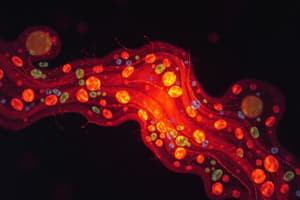Podcast
Questions and Answers
Which type of microscopy allows the differentiation between living and dead cells based on membrane integrity?
Which type of microscopy allows the differentiation between living and dead cells based on membrane integrity?
- Electron Microscopy
- Confocal Microscopy
- Fluorescence Microscopy (correct)
- Phase Contrast Microscopy
What color do dead cells appear when stained with propidium iodide in a combination with Syto 9?
What color do dead cells appear when stained with propidium iodide in a combination with Syto 9?
- Blue
- Red (correct)
- Green
- Yellow
What is the process by which most bacteria reproduce?
What is the process by which most bacteria reproduce?
- Mitosis
- Budding
- Binary fission (correct)
- Meiosis
In flow cytometry, what property is primarily used to sort and separate cells?
In flow cytometry, what property is primarily used to sort and separate cells?
What indicates that viable cells can replicate when performing a viable count?
What indicates that viable cells can replicate when performing a viable count?
During bacterial growth, what happens as the nucleoid expands?
During bacterial growth, what happens as the nucleoid expands?
What measurement indicates a culture's cell count based on density using a spectrophotometer?
What measurement indicates a culture's cell count based on density using a spectrophotometer?
What differentiates symmetrical binary fission from asymmetrical binary fission in bacteria?
What differentiates symmetrical binary fission from asymmetrical binary fission in bacteria?
What is the primary role of the catalase enzyme in bacterial cells?
What is the primary role of the catalase enzyme in bacterial cells?
How does the catalase test help in distinguishing between different bacterial families?
How does the catalase test help in distinguishing between different bacterial families?
What role does quorum sensing play in the development of biofilms?
What role does quorum sensing play in the development of biofilms?
In the context of cystic fibrosis, what impact do biofilms have on respiratory infections?
In the context of cystic fibrosis, what impact do biofilms have on respiratory infections?
What factor primarily contributed to the mortality of the two women with cystic fibrosis in the historical case described?
What factor primarily contributed to the mortality of the two women with cystic fibrosis in the historical case described?
What type of environment do thermophiles thrive in?
What type of environment do thermophiles thrive in?
Which of the following microorganisms is classified as a facultative anaerobe?
Which of the following microorganisms is classified as a facultative anaerobe?
What is a defining characteristic of strict anaerobes?
What is a defining characteristic of strict anaerobes?
Which type of microorganism survives in environments with lower oxygen concentrations?
Which type of microorganism survives in environments with lower oxygen concentrations?
Which of the following statements about catalase is true?
Which of the following statements about catalase is true?
What is the typical pH level of the environment where most pathogens thrive?
What is the typical pH level of the environment where most pathogens thrive?
What characterizes aerotolerant anaerobes?
What characterizes aerotolerant anaerobes?
Which of the following best describes strict aerobes?
Which of the following best describes strict aerobes?
Which environmental condition do halophiles specifically thrive in?
Which environmental condition do halophiles specifically thrive in?
Which of these bacteria is known for rarely being pathogenic due to the extreme conditions they thrive in?
Which of these bacteria is known for rarely being pathogenic due to the extreme conditions they thrive in?
What is the primary product of nitrogen fixation performed by certain bacteria?
What is the primary product of nitrogen fixation performed by certain bacteria?
Which process involves the transformation of ammonia to nitrate?
Which process involves the transformation of ammonia to nitrate?
In the context of urinary tract infections, what does the presence of nitrites in urine usually indicate?
In the context of urinary tract infections, what does the presence of nitrites in urine usually indicate?
Which statement best explains the role of nitrifying bacteria in the nitrogen cycle?
Which statement best explains the role of nitrifying bacteria in the nitrogen cycle?
What happens during denitrification in the nitrogen cycle?
What happens during denitrification in the nitrogen cycle?
When E. coli reduces nitrate in urine, what is the main intermediate compound formed?
When E. coli reduces nitrate in urine, what is the main intermediate compound formed?
Why is nitrogen fixation considered crucial for biosynthesis?
Why is nitrogen fixation considered crucial for biosynthesis?
In the diagnosis of UTIs, what factor is crucial for determining the need for treatment?
In the diagnosis of UTIs, what factor is crucial for determining the need for treatment?
What is the purpose of the nitrite test when analyzing urine for UTIs?
What is the purpose of the nitrite test when analyzing urine for UTIs?
What type of bacteria participates in forming a symbiotic relationship for nitrogen fixation?
What type of bacteria participates in forming a symbiotic relationship for nitrogen fixation?
What defines a hyperthermophile in terms of temperature tolerance?
What defines a hyperthermophile in terms of temperature tolerance?
Which type of microbe would best survive in a highly acidic environment?
Which type of microbe would best survive in a highly acidic environment?
What is a primary characteristic of psychrophiles regarding temperature?
What is a primary characteristic of psychrophiles regarding temperature?
What adaptation allows thermophiles to withstand high temperatures?
What adaptation allows thermophiles to withstand high temperatures?
Which category of extremophile requires high salt concentrations to thrive?
Which category of extremophile requires high salt concentrations to thrive?
What is the optimal temperature range for mesophiles?
What is the optimal temperature range for mesophiles?
Which characteristic is NOT associated with strict anaerobes?
Which characteristic is NOT associated with strict anaerobes?
Which group of microorganisms is primarily responsible for growth at extreme pressures?
Which group of microorganisms is primarily responsible for growth at extreme pressures?
What is a defining feature of normophiles (mesophiles)?
What is a defining feature of normophiles (mesophiles)?
How do psychrophiles maintain cell integrity at low temperatures?
How do psychrophiles maintain cell integrity at low temperatures?
Flashcards are hidden until you start studying
Study Notes
Distinguishing Living from Dead Cells
- Detroff Hausser Counting Chamber allows counting microorganisms directly with a microscope, but visual identification does not confirm liveliness.
- Fluorescence Microscopy distinguishes living from dead cells using dyes:
- Propidium Iodide stains dead cells red by penetrating only energized membranes.
- Syto 9 stains both live and dead cells green.
- Combined application results in living cells appearing green and dead cells appearing red, yellow, or orange.
Flow Cytometry
- FACS (Fluorescence-Activated Cell Sorting) counts and separates cells based on fluorescence.
- Cells flow single-file past a laser for counting and fluorescence intensity measurement, allowing for separation.
- Useful for differentiating bacterial cells with varying fluorescent protein synthesis capabilities.
Viable Counts
- Viable Cells replicate and form colonies (e.g., 100 colonies from 100 ml of 10³ dilution corresponds to 1000 cells/ml).
- Optical Density measures turbidity in liquid cultures via spectrophotometer, indicating cell density.
Bacterial Growth
- Standard growth through binary fission; one parent cell divides to produce two offspring.
- Growth cycle includes nucleoid expansion as DNA replicates.
- Bacteria utilize nitrogen in various transformations: nitrogen fixation (N₂ to NH₄⁺), nitrification (NH₃ to NO₃⁻), and denitrification (NO₃⁻ to N₂).
Nitrogen Cycle and UTIs
- Nitrate Reduction: Some bacteria (e.g., E. coli) convert nitrates (NO₃⁻) in urine to nitrites (NO₂⁻), indicating potential infections.
- Presence of nitrite in urine suggests UTI but requires confirmation since other causes may exist.
Nitrite Test in UTIs
- Sensitivity and Specificity of nitrite tests varies—sensitivity at 25% and specificity at 94%-100%.
- A positive nitrite result usually indicates bacterial presence, especially if lacking in normal urine.
Treatment Considerations
- Infections typically warrant treatment to prevent complications, particularly for asymptomatic bacteriuria or in pregnant patients.
- Potential risk of sepsis and preterm birth linked to untreated infections.
Extremophiles
- Extremophiles thrive in harsh conditions; classified by temperature, pH, salinity, and pressure.
- Thermophiles grow at high temperatures (>55°C), while psychrophiles thrive at low temperatures (as low as -10°C).
- Bacteria employ unique proteins to function under extreme conditions.
Oxygen Utilization
- Strict Aerobes require oxygen for growth and metabolize reactive oxygen species (ROS).
- Strict Anaerobes cannot use oxygen and are often harmed by ROS.
- Facultative Anaerobes can grow with or without oxygen, while Microaerophiles prefer lower oxygen environments.
Catalase Test
- Detects the presence of catalase, an enzyme that decomposes hydrogen peroxide into water and oxygen.
- Catalase-positive bacteria form bubbles upon exposure to hydrogen peroxide; key for differentiating bacterial types.
Biofilms and Quorum Sensing
- Biofilms consist of masses of bacteria adhering to surfaces, offering resistance to treatment.
- Quorum Sensing enables communication and coordinated behavior among bacteria in biofilms.
- Biofilms pose significant challenges in infections, such as in cystic fibrosis-related respiratory illnesses.
Case History Insight
- Cystic fibrosis is linked to compromised chloride transport, leading to severe respiratory conditions.
- The persistence of Pseudomonas aeruginosa in infected patients demonstrates the challenges in treating biofilm-associated infections.
Studying That Suits You
Use AI to generate personalized quizzes and flashcards to suit your learning preferences.




